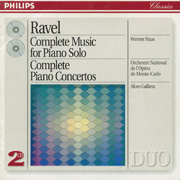
Complete Music for Piano Solo + Piano Concertos
Werner Haas
Orchestre National de l’Opera de Monte-Carlo, Alceo Galliera conducting
1993: Philips Classics/Duo 438 353-2
CD 1
Piano Concerto in G
Gaspard de la nuit
Miroirs
CD 2
Piano Concerto in D «for the left hand»
Le tombeau de Couperin
Sonatine
There’s so much Ravel richness here that I must leave most of my thoughts unexpressed for awhile as I strive to enunciate a few highlights.
Le tombeau de Couperin is one of my favorite Ravel piano pieces—or, rather, most of it is. As both a listener and a pianist I find “Forlane” both capricious and gorgeous, a beautiful cluster of poses like Flamenco distilled to miniature form, and I absolutely adore it. “Fugue” is what its name says it is, although it’s so elliptical and seemingly unstructured that it doesn’t seem so at first; when you do recognize the pattern(s), whether by ear or by playing it yourself, it’s like looking at a beautiful fabric and recognizing the knit as a logical but daunting one (totally appropriate for a fugue, of course)…but it’s a crystalline strand of deftly woven fragments, not a hunk of macrame as some fugues can be when they get overly impressed with their brilliant pattern-work.
In Miroirs, three of the five pieces grab me. Well, actually, only “Alborada del gracioso” fails to do so. “Noctuelles” seems like a nocturnal-yet-hyperactive companion piece to “Oiseaux tristes,” and it contains a handful of those sequences that make it impossible to describe Ravel’s works without using the word “exquisite.” “Oiseaux tristes” itself is a brilliant melding of the abstract and the literal, with bits of birdsong translated into the language of the piano, all delicately draped like a constellation over a moodily indefinite ground. “La vallée des cloches” is the hidden gem here, however. Because of this piece I’ve discovered I’m a sucker for decent “distant churchbells” compositions/recording, those of Timo Väänänen, Loituma, and the Karelian Folk Music Ensemble being the only ones to truly vie for the top slot against Ravel’s effort.
My piano-playing level is nowhere near “expert,” being more “lapsed prodigy” at best and more like “accomplished amateur” overall, and what I love most to play are pieces that shimmer and resonate with harmonic flair and depth. “La vallée des cloches” is one of the many pieces I love to play just for the rapturous joy of playing and hearing that music.
Comments © 2006 Mark Ellis Walker, except as noted, and no claim is made to the images and quoted lyrics.